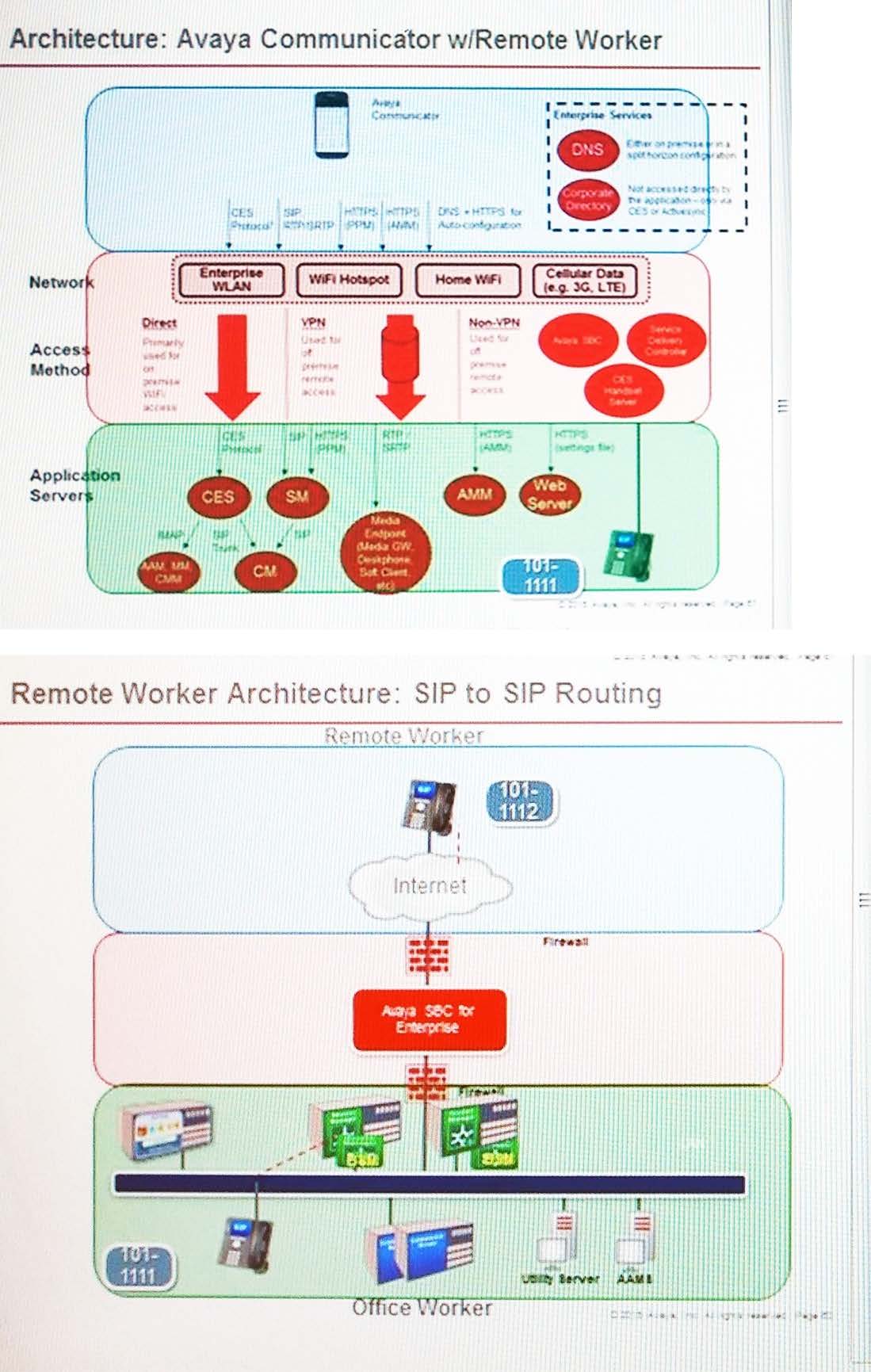Exam Details
Exam Code
:72201XExam Name
:Avaya Aura Core Components Support CertifiedCertification
:Avaya CertificationsVendor
:AvayaTotal Questions
:94 Q&AsLast Updated
:Mar 21, 2025
Avaya Avaya Certifications 72201X Questions & Answers
-
Question 41:
In addition to System Parameters IP options in Communication Manager, System Manager SIP User Communication Profile (remote worker settings), and Media Server (AAMS) Public Network settings, which other area may require troubleshooting for a remote worker connected to a public network, over an office worker connected to the corporate private network?
A. SIP User Profiles in System Manager
B. System Parameters sip options in Communication Manager
C. Session Border Controller configuration
D. Media Server (AAMS) Private Network settings
E. Firewall rules on the remote worker's device
-
Question 42:
What information can be found when running the display node-names ip command?
A. type and link number
B. name and link number
C. IP address and type
D. name and IP address
E. MAC address and IP address
F. type and IP address
-
Question 43:
Which three statements regarding the core architecture in the Avaya Aura 7 solution are true? (Choose three.)
A. SIP trunks can be configured on both Avaya Aura Session Manager (SM) and Avaya Aura Communication Manager (CM).
B. SIP User Agents can register to both Avaya Aura Session Manager (SM) and Avaya Aura Communication Manager (CM).
C. Avaya Aura Media Server (AAMS) can connect to Avaya Aura Communication Manager (CM) without routing via Avaya Aura Session Manager (SM).
D. Avaya Aura Media Server (AAMS) connects directly to Avaya Aura Session Manager (SM) using SIP.
E. Avaya Aura Session Manager (SM) is responsible for routing calls between SIP User Agents.
-
Question 44:
What happens if Session Manager cannot find a matching SIP Communication Profile for a user in its SIP registry when that user tries to make a SIP call?
A. The call is sent to Communication Manager to check if the number dialed exists in CM's call routing tables.
B. The caller receives a busy tone.
C. Network Routing Policy (NRP) is consulted for further routing instructions.
D. The call is routed to voicemail to check if the extension is associated with a mailbox.
E. Session Manager attempts to create a new SIP Communication Profile for the user.
-
Question 45:
In a SIP trace capturing PPM messages, which device sends the getCallHistory PPM request, and what is it requesting?
A. the SIP endpoint; It is requesting its call log to be retrieved from Session Manager.
B. the SIP endpoint; It is requesting its contact list to be retrieved from Session Manager.
C. the Avaya Aura Session Manager (SM) server; It is requesting the call history from System Manager.
D. System Manager; It is requesting the call log history from Communication Manager.
E. Communication Manager; It is requesting the call log history from System Manager.
-
Question 46:
Which Communication Manager command can be used to verify the network region in use by a particular endpoint?
A. display system-parameters ip-option
B. list usage extension
C. status station
D. display ip-network-region
E. status endpoint
-
Question 47:
Refer to the Exhibits.

What is the main difference between the SIP call flow made from an Avaya Communicator Remote Worker and the call flow made from a 96X1 telephone Remote Worker?
A. The 96X1 telephone Remote Worker requires registration to Avaya Aura Session Manager.
B. Avaya Aura Communication Manager processes full call model for the SIP-to- Communicator call flow.
C. The Communicator registers to Avaya Session Border Controller for Enterprise (SBCE).
D. Avaya Aura Communication Manager processes half-call model for the SIP-to-SIP call flow.
-
Question 48:
Session Manager uses five unique certificates for secure communications using Transport Layer Security (TLS). Which two of the following certificates are the most important for communication with other entities?
A. SIP certificates
B. Sal Agent certificates
C. WebSphere certificates
D. HTTPS certificates
E. Management certificates
F. ACME certificates
-
Question 49:
When a call is made between two Avaya SIP Telephones (AST) users, Session Manager processes the call through various phases. What is the maximum number of phase tags that Session Manager uses, and what are they called?
A. Three - ingress, process, egress
B. Two - imsorig and imsterm
C. Two - origappseq and termappseq
D. Four - imsorig, origdone, imsterm, termdone
E. Five - start, connect, progress, alert, end
-
Question 50:
Which of the following commands can you use to check whether the Avaya Aura Session Manager (SM) application processes are running?
A. Execute the SM CLI statapp command.
B. On the SM dashboard, select Status Applications from the Shutdown System pull-down menu.
C. On the SM dashboard, select Status Applications from the Service State pull-down menu.
D. Execute the SM status all command.
E. Use the Linux command ps -ef | grep -i "SM"
Related Exams:
3104
Avaya one-X UC Soft Clients Implementation and Maintenance3107
Avaya Session Border Controller Enterprise Implementation and Maintenance31860X
Avaya IX Calling Design3300
Avaya Aura Contact Center Administration3301
Avaya Aura Contact Centre Maintenance & Troubleshooting3304
Avaya Call Center Elite Implementation and Maintenance3312
Avaya Aura Contact Center Administration3313
Avaya Aura Contact Center Maintenance and Troubleshooting33160X
Avaya Workforce Engagement Support Certified33810X
Avaya Aura Contact Center Solution Design
Tips on How to Prepare for the Exams
Nowadays, the certification exams become more and more important and required by more and more enterprises when applying for a job. But how to prepare for the exam effectively? How to prepare for the exam in a short time with less efforts? How to get a ideal result and how to find the most reliable resources? Here on Vcedump.com, you will find all the answers. Vcedump.com provide not only Avaya exam questions, answers and explanations but also complete assistance on your exam preparation and certification application. If you are confused on your 72201X exam preparations and Avaya certification application, do not hesitate to visit our Vcedump.com to find your solutions here.